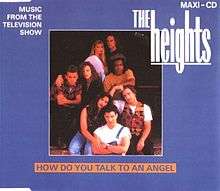How Do You Talk to an Angel
| "How Do You Talk to an Angel" | |
|---|---|
 | |
| Single by The Heights | |
| from the album The Heights (Music from the Television Show) | |
| Released | September 5, 1992 |
| Format | CD single |
| Recorded | January 20, 1992 |
| Genre | Pop rock |
| Length | 3:50 |
| Label | Capitol |
| Writer(s) | Steve Tyrell (composer), Barry Coffing (composer), Stephanie Tyrell (lyricist) |
| Certification | Gold (RIAA) |
"How Do You Talk to an Angel" is a song written by Steve Tyrell, Barry Coffing, and Stephanie Tyrell. It was the theme for the TV series The Heights. The single was released with Jamie Walters as lead singer, and it hit number one on the Billboard Hot 100 on November 14, 1992, but the series was canceled exactly one week after the song fell from its number one position.[1] Vocalists on the single included Cheryl Pollak, Charlotte Ross of NYPD Blue and Glee fame, as well as Zachary Throne from the Las Vegas rock band, Sin City Sinners.
In 1993, the song was nominated for an Emmy Award for "Outstanding Individual Achievement in Music and Lyrics". The Emmy went to the song "Sorry I Asked" by Liza Minnelli.
No follow-up singles under The Heights name were ever released. Walters, the lead singer on the single and the lead actor on the show, later had a #15 Hot 100 hit with his single "Hold On" in 1994.[2] It was his only subsequent chart appearance.
Charts
Weekly charts
| Weekly chart (1992-93) | Peak position |
|---|---|
| Australia (ARIA)[3] | 3 |
| Belgium (Ultratop 50 Flanders)[4] | 12 |
| Canada Adult Contemporary Tracks (RPM)[5] | 12 |
| Canada Top Singles (RPM)[6] | 2 |
| Germany (Official German Charts)[7] | 47 |
| Netherlands (Single Top 100)[8] | 60 |
| US Billboard Adult Contemporary | 8 |
| US Billboard Hot 100 | 1 |
| US Billboard Rhythmic Top 40 | 13 |
| US Billboard Top 40 Mainstream | 1 |
End of year charts
| Year-end chart (1992) | Position |
|---|---|
| U.S. Billboard Hot 100[9] | 59 |
| Year-end chart (1993) | Position |
|---|---|
| Australian (ARIA) chart[10] | 24 |
References
- ↑ Bronson, Fred (2003). The Billboard Book Of Number 1 Hits (5 ed.). Billboard Books. p. 812. ISBN 0-8230-7677-6.
- ↑ Hold On - Jamie Walters | Billboard.com
- ↑ "Australian-charts.com – The Heights – How Do You Talk to an Angel". ARIA Top 50 Singles.
- ↑ "Ultratop.be – The Heights – How Do You Talk to an Angel" (in Dutch). Ultratop 50.
- ↑ Canadian Adult Contemporary peak
- ↑ Canadian Top Singles peak
- ↑ "Musicline.de – The Heights Single-Chartverfolgung" (in German). Media Control Charts. PhonoNet GmbH.
- ↑ "Dutchcharts.nl – The Heights – How Do You Talk to an Angel" (in Dutch). Single Top 100.
- ↑ "Billboard Top 100 - 1992". Retrieved 2010-07-30.
- ↑ "ARIA Charts - End Of Year Charts - Top 50 Singles 1993". ARIA. Retrieved 2014-12-09.
| Preceded by "End of the Road" by Boyz II Men |
Billboard Hot 100 number one single November 14, 1992- November 21, 1992 |
Succeeded by "I Will Always Love You" by Whitney Houston |